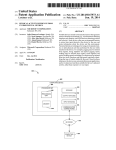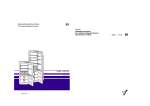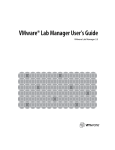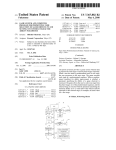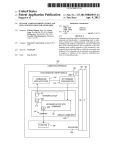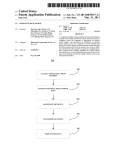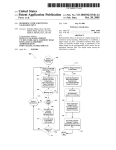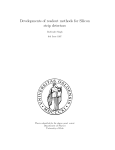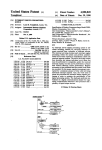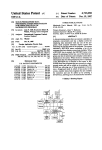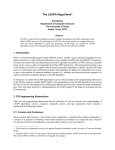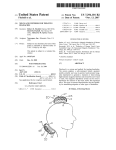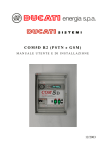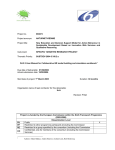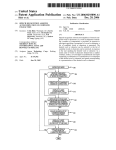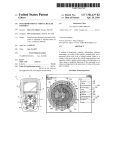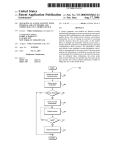Download _l I 1—% IIF
Transcript
US 20140181715A1
(19) United States
(12) Patent Application Publication (10) Pub. No.: US 2014/0181715 A1
Axelrod et al.
(43) Pub. Date:
Jun. 26, 2014
(54)
DYNAMIC USER INTERFACES ADAPTED TO
INFERRED USER CONTEXTS
(52)
US. Cl.
CPC .................................. .. G06F 3/0484 (2013.01)
USPC
(71) Applicant: MICROSOFT CORPORATION,
(57)
Redmond, WA (US)
(72)
........................................................ ..
715/771
ABSTRACT
A device comprising a set of environment detectors may
detect various environmental properties (e. g., location, veloc
ity, and vibration), and may infer from these environmental
Inventors: Elinor Axelrod, Kfar-Sirkin (IL); Hen
Fitoussi, Tel-Aviv (IL)
properties a current context of the user (e.g., the user’s atten
tion availability, privacy, and accessible input and output
(73) Assignee: Microsoft Corporation, Redmond, WA
(Us)
modalities). Based on the current context, the device may
adjust the presentation of various user interface elements of
an application. For example, the velocity and vibration level
detected by the device may enable an inference of the mode of
(21) Appl. No.: 13/727,137
(22)
Filed:
transport of the user (e.g., stationary, walking, jogging, driv
ing a car, or riding on a bus), and each mode of transport may
Dec. 26, 2012
suggest the user’s available input modality (e. g., text, touch,
speech, or gaze tracking) and/ or output modality (e. g., high
detail visual, simpli?ed visual, or audible), and the applica
tion may select and present corresponding element presenta
Publication Classi?cation
(51)
Int. Cl.
G06F 3/0484
tions for input and output user interface elements, and/ or the
(2006.01)
detail of presented content.
300
302
W
USER INTERFACE
304
304
304
I DIRECTIONS
302
I
302
USER INTERFACE
CONTROLS I
I
302
I
USER INTERFACE
306
9
MAP
USER INTERFACE
306
300
DIRECTIONS
DIRECTIONS
DIRECTIONS
T RNRI HT
T RNR| HT
RIGHT ON RT I
U
G
U
306 A
G
LEFT ON HWY 3...
306 -\
306 -\
MAP
MAP
MAP
%
_____ "E5"
_ _ _| _ _ _
_l I 1—
% I IF
306
306
306
CONTROLS
CONTROLS
))) FIND FUEL
A
PAUSE STOP
I
118
SPEECH
110
OUTPUT
SPEECH
A
I
110
I
TOUCH
118
INPUT
VISUAL
OUTPUT
“22%
206
CONTEXT; DRIVING I
U
SHOW DIRECTIONS I
118
VIBRATE
OUTPUT
INPUT
206
CONTROLS
SEARCH:
I
A
A
110
113
/_ “8
DETAIL
TEXT
BASIC
TEXT
OUTPUT
TEXT
INPUT
0 W T
U U
206
I CONTEXT: JOGGING I
I CONTEXT: SITTINC
l
4
108 -\ MODALITY
“1
EM
SPEECH
INPUT
H0
SPEECH
OUTPUT
106
ENWRONMENTALSENSOR
(GPS RECEIVER)
106
104
>
08
géé
MOOALITY
Q99
110
INPUT
110
WSUAL
OUTPUT
ENVIRONMENTAL SENSOR
'
(ACCELEROMETER)
106
ENVIRONMENTAL SENSOR
(MICROPHONE)
Patent Application Publication
Jun. 26, 2014 Sheet 1 0f 7
US 2014/0181715 A1
100 w
112 -\
112
MAPPING APPLICATION
112
JOGGING APPLICATION
READING APPLICATION
114
114 w
:_—_—_:
114
______ _ _
DISTANCE:
114
:12;
4-85 km
116
1:55;;
5—2??? 5—22—22
116
_“__
i
___
_
116
I
A
_—_—_—_—_—_
5522:: £552
A
PAUSE
STOP
NEXT BACK MENU
A
A
A
TOUCH
TEXT
TOUCH
TEXT
|NPUT
OUTPUT
|NPUT
OUTPUT
k
118
SPEECH
SPEECH
|NPUT
I
118
VISUAL
OUTPUT
108
MODALITY
110
SPEECH
INPUT
102
106
110
"
SPEECH
OUTPUT
108
‘
ENVIRONMENTAL SENSOR
'
(GPS RECEIVER)
106
104
MODALITY
ENVIRONMENTAL SENSOR
(ACCELEROMETER)
110
TOUCH
106
ENVIRONMENTAL SENSOR
|NPUT
(MICROPHONE)
11o
VISUAL
OUTPUT
FIG. 1
Patent Application Publication
Jun. 26, 2014 Sheet 2 0f 7
106 j
US 2014/0181715 A1
106
ACCELEROMETER
GPS RECEIVER
r 202
W
—> —> —> —> —> —>
I 204 q
206
CURRENT CONTEXT: JOGGING
102
202_
106
ACCELEROMETER
106
GPS RECEIVER
/-202
W
I 204
104
O o 0 0 o 0
I
206
CURRENT CONTEXT: JOGGING (TREADMILL)
106
106 -\
ACCELEROMETER
GPS RECEIVER
I 204
206
CURRENT CONTEXT: WALKING
102
106
106
ACCELEROMETER
GPS RECEIVER
202 -
—
r 202
104
204 ‘\
206 _\
I
I
CURRENT CONTEXT; VEHICLE RIDING
106—\
102
106
ACCELEROMETER
GPS RECEIVER
202w
r202
_—
104
O G
O O O O
204
206
I
I
CURRENT CONTEXT: SITTING
FIG. 2
Patent Application Publication
300 w
US 2014/0181715 A1
Jun. 26, 2014 Sheet 3 0f 7
302
USER INTERFACE
304
304
304
DIRECTIONS
MAP
CONTROLS
302
$
302
USER INTERFACE
$
302
{I
USER INTERFACE
306
USER INTERFACE
306
306 A
DIRECTIONS
DIRECTIONS
)>> TURN RIGHT
TURN RIGHT
306 A
DCIQRECC‘JI'IONS
N RT 1
RI HT
LEFT ON HWY 3m
306 A
306 -\
MAP
306
CONTROLS
CONTROLS
))> FIND FUEL
CONTROLS
SEARCH:
PAUSE STOP
[:1
SHOW DIRECTIONS
A
k
$/_ 118
SPEECH
110A
OUTPUT
SPEECH
A
110A
]
A
VlBIgATém
OUTPUT
TOUCH
I
110
DETgLHa
113
INPUT
206
“8
INPUT
BASIC
VISUAL
TEXT
OUTPUT
OUTPUT
mmeI
206
mTwmI
CONTEXT: DRIVING |
206
ICONTEXT:JOGGING ]
TEXT
TEXT
INPUT
OUTPUT
,
| CONTEXT: SITTING
l
I
1°3"\ MODALITY
102
110
SPEECH
INPUT
106
ENVIRONMENTAL SENSOR
110
SPEECH
(GPS RECEIVER)
‘
'
OUTPUT
106
~—
104 .\ DO
103
ENVIRONMENTAL SENSOR
(3.38
MODALITY
(DO
Q28)
“EOUCH
OUTPUT
106\
ENVIRONMENTAL SENSOR
INPUT
110
VISUAL
(ACCELEROMETER)
M
(MICROPHONE)
FIG- 3
Patent Application Publication
Jun. 26, 2014 Sheet 4 0f 7
US 2014/0181715 A1
400
w
402
START
f
EXECUTE ON PROCESSOR INSTRUCTIONS CONFIGURED TO:
404
/
406
/
408
/_
410
/—
412
RECEIVE FROM ENVIRONMENTAL SENSOR
AT LEAST ONE ENVIRONMENTAL PROPERTY
OF CURRENT ENVIRONMENT OF USER
FROM ENVIRONMENTAL PROPERTIES,
INFER CURRENT CONTEXT OF USER
FOR USER INTERFACE ELEMENTS OF USER INTERFACE,
FROM AT LEAST TWO ELEMENT PRESENTATIONS
RESPECTIVELY ASSOCIATED WITH CONTEXT OF USER,
SELECT A SELECTED ELEMENT PRESENTATION
THAT IS ASSOCIATED WITH CURRENT CONTEXT OF USER
PRESENT SELECTED ELEMENT PRESENTATIONS
OF USER INTERFACE ELEMENTS OF USER INTERFACE
414
END
FIG. 4
Patent Application Publication
500
Jun. 26, 2014 Sheet 5 0f 7
US 2014/0181715 A1
w
502
DEVICE
302
508
USER INTERFACE
ELEMENT PRESENTATION SET
304
306
206 1
USER
INTERFACE
> PREg'éi?i?gN 1 + CONTEXT 1
ELEMENT 1
304
306
USER
INTERFACE
ELEMENT 2
504 \
206 \
ELEMENT
-> CONTEXT2
PRESENTATION 2
510
SYSTEM
CURRENT CONTEXT
INFERRING
COMPONENT
USER INTERFACE
PRESENTING
COMPONENT
A
A
202
v
ENVIRONMENTAL
PROPERTY
106
A
l
}
-/-'-5-°-6,
102I
I
{—
:
:
|
I:
l
CURRENT
CONTEXT
306
PRESENTATION
112
ENVIRONMENTAL
SENSOR
I ---- I
206 A
202
ENVIRONMENTAL
PROPERTIES
l
FIG. 5
v
APPLICATION
Patent Application Publication
Jun. 26, 2014 Sheet 6 0f 7
US 2014/0181715 A1
600 X
608‘\y _________________ __\
I
c::3
I
I
.
I
I
I
I
I
I
I
I
I
I
I
I
I
I
I
I
I
I
I
I
I
I
I
I
I
I
I
I
I
I
I
I
I
I
\ \~
~
~
~
~
~
~
~
~
_
_
_
_
_
_
606
COMPUTER
INSTRUCUONS
604
01011010001010
10101011010101
101101011100...
_
_
_
_/I
Patent Application Publication
700
Jun. 26, 2014 Sheet 7 0f 7
US 2014/0181715 A1
x
702
COMPUTING DEVICE
/-704
TV _ "PPOOEsws'OP 'éETH' *1;
5
706
{
I
71°
STORAGE
l
i
PROCESSING
I
1
UNIT
;
l
I
I
1
;
[
5
;
I
712
;
MEMORY
OUTPUT DEVICE(S)
f'm
INPUT DEVICE(S)
{
;
,
1
{
COMMUNICATION
;
CONNECTIONS)
:
708
'
L
/-—716
l
_
_
_
_
_
_
_
_
_
_
_
_
_
_
_
_
_
_
_
_I
718
COMPUTING /-720
DEVICE
FIG. 7
US 2014/0181715 A1
DYNAMIC USER INTERFACES ADAPTED TO
INFERRED USER CONTEXTS
Jun. 26, 2014
of the user, the user interface of an application is typically
presented statically until and unless explicitly adjusted by the
user to suit the user’s current context.
BACKGROUND
[0005] However, it may be appreciated that the user inter
face of an application may be dynamically adjusted to suit the
[0001] Within the ?eld of computing, many scenarios
involve devices that are used during a variety of physical
activities. As a ?rst example, a music player may play music
that such adjustments may be selected not (only) in response
while a user is sitting at a desk, walking on a treadmill, or
to user input from the user and/or the detected environment
current context inferred about the user. It may be appreciated
jogging outdoors. The environment and physical activity of
properties of the environment (e. g., adapting the brightness in
the user may not alter the functionality of the device, but it
view of the detected ambient light level), but also in view of
may be desirable to design the device for adequate perfor
the context of the user.
mance for a variety of environments and activities (e. g., head
phones that are both comfortable for daily use and suf?ciently
device to infer a current context of the user, based on the
[0006]
Presented herein are techniques for con?guring a
snug to stay in place during exercise). As a second example,
environmental properties provided by the environmental sen
a mobile device, such as a phone, may be used by a user who
sors, and to adjust the user interface of an application to
is stationary, walking, or riding in a vehicle. The mobile
ment that are usable by the applications. For example, the
mobile device may include a global positioning system (GPS)
receiver con?gured to detect a geographical position, altitude,
satisfy the user’s inferred current context. For example, in
contrast with adjusting the volume level of a device in view of
a detected noise level of the environment, the device may
infer from the detected noise level the privacy level of the user
(e.g., whether the user is in a location occupied by other
individuals or is alone), and may adjust the user interface
according to the inferred privacy as the current context of the
user (e. g., obscuring private user information while the user is
in the presence of other individuals). Given the wide range of
current contexts of the user (e.g., the user’s location type,
and velocity of the user, and a gyroscope or accelerometer
privacy level, available attention, and accessible input and
con?gured to detect a physical orientation of the mobile
device. This environmental data may be made available to
output modalities), various user interface elements of the user
interface may be selected from at least two element presen
tations (e.g., a user input modality may be selected from a
computer may store a variety of applications that a user may
wish to utilize in different contexts (e.g., a jogging application
that may track the user’s progress during jogging, and a
reading application that the user may use while seated). To
this end, the mobile device may also feature a set of environ
mental sensors that detect various properties of the environ
respective applications, which may utilize it to facilitate the
operation of the application.
text, touch, voice, and gaze modalities). Many types of cur
[0002] Additionally, the user may manipulate the device as
a form of user input. For example, the device may detect
various gestures, such as touching a display of the device,
shaking the device, or performing a gesture in front of a
rent contexts of the user may be inferred based on many types
camera of the device. The device may utilize various environ
mental sensors to detect some environmental properties that
reveal the actions communicated to the device by the user, and
may extract user input from these environmental properties.
SUMMARY
[0003]
This Summary is provided to introduce a selection
of concepts in a simpli?ed form that are further described
of environmental properties may enable the selection among
many types of dynamic user interface adjustments in accor
dance with the techniques presented herein.
[0007] To the accomplishment of the foregoing and related
ends, the following description and annexed drawings set
forth certain illustrative aspects and implementations. These
are indicative of but a few of the various ways in which one or
more aspects may be employed. Other aspects, advantages,
and novel features of the disclosure will become apparent
from the following detailed description when considered in
conjunction with the annexed drawings.
below in the Detailed Description. This Summary is not
intended to identify key factors or essential features of the
claimed subject matter, nor is it intended to be used to limit
the scope of the claimed subject matter.
[0004] While respective applications of a mobile device
may utilize environmental properties received from environ
mental sensors in various ways, it may be appreciated that this
environmental information is typically used to indicate the
status of the device (e.g., the geolocation and orientation of
the device may be utilized to render an “augmented reality”
application) and/or the status of the environment (e.g., an
ambient light sensor may detect a local light level in order to
adjust the brightness of the display). However, this informa
tion is not typically utilized to determine the current context
of the user. For example, when the user transitions from
walking to riding in a vehicle, the user may manually switch
from a ?rst application that is suitable for the context of
walking (e. g., a pedestrian mapping application) to a second
application that is suitable for the context of riding (e.g., a
DESCRIPTION OF THE DRAWINGS
[0008] FIG. 1 is an illustration of an exemplary scenario
featuring a device comprising a set of environmental sensors
and con?gured to execute a set of applications.
[0009] FIG. 2 is an illustration of an exemplary scenario
featuring an inference of a physical activity of a user through
environmental properties according to the techniques pre
sented.
[0010] FIG. 3 is an illustration of an exemplary scenario
featuring a dynamic composition of a user interface using
element presentations selected for the current context of the
user in accordance with the techniques presented herein.
[0011]
FIG. 4 is a ?ow chart illustrating an exemplary
method of inferring physical activities of a user based on
environmental properties.
driving directions mapping application). While each applica
[0012] FIG. 5 is a component block diagram illustrating an
exemplary system for inferring physical activities of a user
tion may use environmental properties in the current context
based on environmental properties.
US 2014/0181715 A1
Jun. 26, 2014
FIG. 6 is an illustration of an exemplary computer
112 may use a light level sensor to detect the light level of the
readable medium comprising processor-executable instruc
environment, and to set the brightness of a display component
for comfortable viewing of the displayed text.
[0013]
tions con?gured to embody one or more of the provisions set
forth herein.
[0014]
FIG. 7 illustrates an exemplary computing environ
ment wherein one or more of the provisions set forth herein
may be implemented.
DETAILED DESCRIPTION
[0015] The claimed subject matter is now described with
reference to the drawings, wherein like reference numerals
are used to refer to like elements throughout. In the following
description, for purposes of explanation, numerous speci?c
details are set forth in order to provide a thorough understand
[0018] Additionally, respective applications 112 may
present different types of user interfaces that are customized
based on the context in which the application 112 is to be
used. Such customization may include the use of the environ
mental sensors 106 to communicate with the user 102 through
a variety of modalities 108. For example, a speech modality
108 may include speech user input 110 received through the
microphone and speech output produced through a speaker,
while a visual modality 108 may comprise touch user input
110 received through a touch-sensitive display component
and visual output presented on the display. In these ways, the
information provided by the environmental sensors 106 may
ing of the claimed subject matter. It may be evident, however,
that the claimed subject matter may be practiced without
these speci?c details. In other instances, structures and
be used to receive user input 110 from the user 102, and to
output information to the user 102. In some such devices 104,
the environmental sensors 106 may be specialized for user
devices are shown in block diagram form in order to facilitate
input 110; e.g., the microphone may be con?gured for par
ticular sensitivity to receive voice input and to distinguish
such voice input from background noise.
describing the claimed subject matter.
A. INTRODUCTION
[0016]
Within the ?eld of computing, many scenarios
involve a mobile device operated by a user in a variety of
contexts and environments.As a ?rst example, a music player
may be operated by a user during exercise and travel, as well
as while stationary. The music player may be designed to
support use in variable environments, such as providing solid
state storage that is less susceptible to damage through move
ment; a trans?ective display that is visible in both indoor and
outdoor environments; and headphones that are both comfort
able for daily use and that stay in place during rigorous
exercise. While not altering the functionality of the device
between environments, these features may promote the use of
the mobile device in a variety of contexts. As a second
example, a mobile device may offer a variety of applications
that the user may utilize in different contexts, such as travel
oriented applications, exercise-oriented applications, and sta
tionary-use applications. Respective applications may be cus
[0019] Moreover, respective applications 112 may be
adapted to present user interfaces that interact with the user
102 according to the context in which the application 112 is to
be used. As a ?rst example, the mapping application 112 may
be adapted for use while traveling, such as driving a car or
riding a bicycle, wherein the user’s attention may be limited
and touch-based user input 110 may be unavailable, but
speech-based user input is suitable. The user interface may
therefore present a minimal visual interface with a small set of
large user interface elements 114, such as a simpli?ed depic
tion of a road and a directional indicator. More detailed infor
mation may be presented as speech output 118, and the appli
cation 112 may communicate with the user 102 through
speech-based user input 110 (e. g., voice-activated commands
detected by the microphone), rather than touch-based user
input 110 that may be dangerous while traveling. The appli
cation 112 may even refrain from accepting any touch-based
input in order to discourage distractions. As a second
tomized for a particular context, e.g., by presenting user
example, the jogging application 112 may be adapted for the
interfaces that are well-adapted to the use context.
[0017] FIG. 1 presents an illustration of an exemplary sce
touch input availability, and no speech input availability.
nario 100 featuring a device 104 operated by a user 102 and
usable in different contexts. In this exemplary scenario 100,
the device 104 features a mapping application 112 that is
customized to assist the user 102 while traveling on a road,
such as by automobile or bicycle; a jogging application 112,
which assists the user 102 in tracking the progress of a jog
ging exercise, such as the duration of the jog, the distance
traveled, and the user’s pace; and a reading application 112,
which may present documents to a user 102 that are suitable
for a stationary reading experience. The device 104 may also
feature a set of environmental sensors 106, such as a global
positioning system (GPS) receiver con?gured to identify a
position, altitude, and velocity of the device 104; an acceler
ometer or gyroscope con?gured to detect a tilt orientation of
the device 104; and a microphone con?gured to receive sound
input. Additionally, respective applications 112 may be con
?gured to utilize the information provided by the environ
mental sensors 106. For example, the mapping application
context of a user 102 with limited visual availability, limited
Accordingly, the user interface may present a small set of
large user interface elements 114 through text output 118 that
may be received through a brief glance, and a small set of
large user interface controls 116, such as large buttons that
may be activated with low-precision touch input. As a third
example, the reading application 112 may be adapted for a
reading environment based on a visual modality 108 involv
ing high visual output 118 and precise touch-based user input
110, but reducing audial interactions that may be distracting
in reading environments such as a classroom or library.
Accordingly, the user interface for the reading application
112 may interact only through touch-baseduser input 110 and
textual user interface elements 114, such as highly detailed
renderings of text. In this manner, respective applications 112
may utilize the environmental sensors 106 for environment
based context and for user input 110 received from the user
102, and may present user interfaces that are well-adapted to
the context in which the application 112 is to be used.
112 may detect the current location of the device in order to
display a localized map; the jogging application 112 may
detect the current speed of the device 104 through space in
order to track distance traveled; and the reading application
B. PRESENTED TECHNIQUES
[0020]
The exemplary scenario 100 of FIG. 1 presents sev
eral advantageous uses of the environmental sensors 106 to
US 2014/0181715 A1
Jun. 26, 2014
facilitate the applications 112, and several adaptations of the
lower- speed direction of travel indicated by the GPS receiver.
user interface elements 114 and user interface controls 116 of
As a fourth example, when the user 102 is seated on a moving
vehicle such as a bus, the accelerometer may detect a latent
respective applications 112 to suit the context in which the
application 112 is likely to be used. In particular, as used in
the exemplary scenario 100 of FIG. 1, the environmental
properties detected by the environmental sensors 106 may be
interpreted as the status of the device 104 (e. g., its position or
orientation), the status of the environment (e.g., the local
sound level), or explicit communication with the user 102
(e. g., touch-based or speech-based user input 110). However,
the environmental properties may also be used as a source of
information about the context of the user 102 while using the
device 104. For example, while the device 104 is attached to
the user 102, the movements of the user 102 and environmen
tal changes caused thereby may enable an inference about
various properties of the location of the user, including the
type of location; the presence and number of other individuals
in the proximity of the user 102, which may enable an infer
ence of the privacy level of the user 102; the attention avail
ability of the user 102 (e. g., whether the attention of the user
102 is readily available for interaction, or whether the user
102 may be only periodically interrupted); and the input
vibration (e. g., based on road unevenness) and the GPS
receiver may detect high-velocity directional movement,
leading to an inference 204 of a vehicle riding context 206. As
a ?fth example, when the user 1 02 is seated and stationary, the
accelerometer and GPS receiver may both indicate very-low
magnitude environmental properties 202, and the device 104
may reach an inference 204 of a stationary context 206. In this
manner, a device 104 may infer the current context 206 of the
user 102 based on the environmental properties 202 detected
by the environmental sensors 106.
[0022] FIG. 3 presents an illustration of an exemplary sce
nario 300 featuring the use of an inferred current context 206
of the user 102 to achieve a dynamic, context-aware compo
sition of a user interface 302 of an application 112. In this
exemplary scenario 300, a user 102 may operate a device 104
having a set of environmental sensors 106 con?gured to
detect various environmental properties 202, from which a
current context 206 of the user 102 may be inferred. More
over, various contexts 206 may be associated with various
modalities that may be accessible to the user 102 (e.g.,
whether the user 102 is available to receive visual output,
audial output, or tactile output such as vibration, and whether
types of modalities 108; e.g., each context 206 may involve a
the user 1 02 is available to provide input through text, manual
forms of output 118 selected from a set of output modalities
108.
touch, device orientation, voice, or eye gaze). An application
112 comprising a set of user interface elements may therefore
be presented by selecting, for respective user interface ele
ments, an element presentation that Is suitable for the current
context of the user 102. Moreover, this dynamic composition
of the user interface may be performed automatically (e.g.,
not in response to user input directed by the user 102 to the
device 104 and specifying the user’s current context), and in
a more sophisticated manner than directly using the environ
mental properties, which may be of limited value in selecting
element presentations for the user 102.
[0021]
FIG. 2 presents an illustration of an exemplary sce
nario 200 featuring an inference of a current context 206 of a
user 102 of a device 104 based on environmental properties
selection of one or more forms of input 110 selected from a set
of input modalities 108, and/or a selection of one or more
[0023] In view of this information, the device 104 may
present an application 112 comprising a user interface 302
comprising a set of user interface elements 304, such as a
mapping application 112 involving a directions user interface
element 304; a map user interface element 304; and a controls
user interface element 304. In view of the inferred current
context 206 of the user 102, the device 104 may select, for
each user interface element 304, an element presentation 306
that is suitable for the context 206. As a ?rst example, the
mapping application 112 may be operated in a driving context
206, in which the user input 110 of the user 102 is limited to
speech, and the output 118 of the user interface 302 involves
speech and simpli?ed, driving-oriented visual output. The
202 reported by respective environmental sensors 106,
directions user interface element 304 may be presented as
including an accelerometer and a global positioning system
voice directions; the mapping user interface element 304 may
(GPS) receiver. As a ?rst example, the user 102 may engage in
a jogging context 206 while attached to the device 104. Even
when the user 102 is not directly interacting with the device
104 (in the form of user input), the environmental sensors 106
present a simpli?ed map with driving directions; and the
controls user interface element 306 may involve a non-visual,
speech analysis technique. As a second example, the mapping
application 112 may be operated in a jogging context 206, in
may detect various properties of the environment that enable
which the user input 110 of the user 102 is limited to com
an inference 204 of the current context 206 of the user 102.
paratively inaccurate touch, and the output 118 of the user
For example, the accelerometer may detect environmental
interface 302 involves vibration and simpli?ed, pedestrian
properties 202 indicating a modest repeating impulse caused
by the user’s footsteps while jogging, while the GPS receiver
also detects a speed that is within the typical speed ofjogging
oriented visual output. The directions user interface element
304 may be presented as vibrational directions (e.g., buZZing
user 102 may perform a jogging exercise on a treadmill.
once for a left turn and twice for a right turn); the mapping
user interface element 304 may present a simpli?ed map with
pedestrian directions; and the controls user interface element
306 may involve large buttons and large text that are easy to
view and activate while jogging. As a third example, the
While the accelerometer may detect and report the same
mapping application 112 may be operated in a stationary
pattern of modest repeating impulses, the GPS receiver may
context 206, such as while sitting at a workstation and plan
ning a trip, in which the user input 110 of the user 102 is
context 206. Based on these environmental properties 202,
the device 104 may therefore perform an inference 204 of the
jogging context 206 of the user 102. As a second example, the
indicate that the user 102 is stationary. The device 104 may
therefore perform an evaluation resulting in an inference 204
of a treadmill jogging context 206. As a third example, a
walking context 206 may be inferred from a ?rst environmen
tal property 202 of a regular set of impulses having a lower
magnitude than for the jogging context 206 and a steady but
robustly available as text input and highly accurate pointing
controls, and the output 118 of the user interface 302 involves
detailed text and high-quality visual output. The directions
user interface element 304 may be presented as a detailed,
textual description of directions; the mapping user interface
US 2014/0181715 A1
element 304 may present a hi ghly detailed and interactive
map; and the controls user interface element 306 may involve
a sophisticated set of user interface controls providing exten
sive map interaction. In this manner, the user interface 302 of
the application 112 may be dynamically composed based on
the current context 206 of the user 102, which in turn may be
automatically inferred from the environmental properties 202
detected by the environmental sensors 106, in accordance
with the techniques presented herein.
C. EXEMPLARY EMBODIMENTS
[0024] FIG. 4 presents a ?rst exemplary embodiment of the
techniques presented herein, illustrated as an exemplary
method 400 of presenting a user interface 302 to a user 102 of
a device 104 having a processor and an environmental sensor
Jun. 26, 2014
510 further comprises a user interface presenting component
514 that is con?gured to, for respective user interface ele
ments 304 of the user interface 302, from an element presen
tation set 508 comprising at least two element presentations
306 that are respectively associated with a context 206 of the
user 102, select a selected element presentation 306 that is
associated with the current context 206 of the user 102 as
inferred by the current context inferring component 512; and
to present the selected element presentations 306 of the user
interface elements 304 of the user interface 302 to the user
102. In this manner, the interoperating components of the
exemplary system 510 enable the presentation of the user
interface 302 in a manner that is dynamically adjusted based
on the inference of the current context 206 of the user 102 in
accordance with the techniques presented herein.
106. The exemplary method 400 may be implemented, e.g., as
a set of processor-executable instructions stored in a memory
[0026]
component of the device 104 (e. g., a memory circuit, a solid
state storage device, a platter of a hard disk drive, or a mag
netic or optical device) that, when executed on a processor of
the device, cause the device to operate according to the tech
able medium comprising processor-executable instructions
con?gured to apply the techniques presented herein. Such
computer-readable media may include, e.g., computer-read
niques presented herein. The exemplary method 400 begins at
402 and involves executing 404 the instructions on the pro
cessor. Speci?cally, the instructions may be con?gured to
receive 406 from the environmental sensor 106 at least one
environmental property 202 of a current environment of the
user 102. The instructions are also con?gured to, from the at
least one environmental property 202, infer 408 a current
context 206 of the user 102. The instructions are also con?g
ured to, for respective user interface elements 304 of the user
interface 302, from at least two element presentations 306
respectively associated with a context 206 of the user 102,
select 410 a selected element presentation 306 that is associ
ated with the current context 206 of the user 102. The instruc
tions are also con?gured to present 412 the selected element
presentations 306 of the user interface elements 304 of the
user interface 302. By compositing the user interface 302
based on the inference of the context 206 of the user 102 from
the environmental properties 202 provided by the environ
Still another embodiment involves a computer-read
able storage media involving a tangible device, such as a
memory semiconductor (e. g., a semiconductor utiliZing static
random access memory (SRAM), dynamic random access
memory (DRAM), and/or synchronous dynamic random
access memory (SDRAM) technologies), a platter of a hard
disk drive, a ?ash memory device, or a magnetic or optical
disc (such as a CD-R, DVD-R, or ?oppy disc), encoding a set
of computer-readable instructions that, when executed by a
processor of a device, cause the device to implement the
techniques presented herein. Such computer-readable media
may also include (as a class of technologies that are distinct
from computer-readable storage media) various types of
communications media, such as a signal that may be propa
gated through various physical phenomena (e.g., an electro
magnetic signal, a sound wave signal, or an optical signal)
and in various wired scenarios (e.g., via an Ethernet or ?ber
optic cable) and/or wireless scenarios (e.g., a wireless local
area network (WLAN) such as WiFi, a personal area network
(PAN) such as Bluetooth, or a cellular or radio network), and
mental sensors 106, the exemplary method 400 operates
according to the techniques presented herein, and so ends at
which encodes a set of computer-readable instructions that,
414.
[0025]
implement the techniques presented herein.
FIG. 5 presents a second embodiment of the tech
niques presented herein, illustrated as an exemplary scenario
500 featuring an exemplary system 510 con?gured to present
a user interface 302 that is dynamically adjusted based on an
inference of a current context 206 of a current environment
when executed by a processor of a device, cause the device to
[0027] An exemplary computer-readable medium that may
be devised in these ways is illustrated in FIG. 6, wherein the
implementation 600 comprises a computer-readable medium
506 ofa user 102 of the device 502. The exemplary system
602 (e.g., a CD-R, DVD-R, or a platter of a hard disk drive),
on which is encoded computer-readable data 604. This com
510 may be implemented, e. g., as a set of interoperating
puter-readable data 604 in turn comprises a set of computer
components, each respectively comprising a set of instruc
tions stored in a memory component (e. g., a memory circuit,
ciples set forth herein. In one such embodiment, the proces
instructions 606 con?gured to operate according to the prin
a solid-state storage device, a platter of a hard disk drive, or a
sor-executable instructions 606 may be con?gured to perform
magnetic or optical device) of a device 502 having an envi
ronmental sensor 106, such that, when the instructions are
a method of adjusting a user interface 302 inferring user
context of a user 102 based on environmental properties, such
executed on a processor 504 of the device 502, cause the
as the exemplary method 510 of FIG. 5. In another such
device 502 to apply the techniques presented herein. The
exemplary system 510 comprises a current context inferring
embodiment, the processor-executable instructions 506 may
be con?gured to implement a system for inferring physical
component 512 con?gured to infer a current context 206 of
the user 1 02 by receiving, from the environmental sensor 1 06,
the exemplary system of FIG. 5. Some embodiments of this
at least one environmental property 202 of a current environ
ment 506 of the user 102, and to, from the at least one
environmental property 202, infer a current context 206 of the
user 102 (e.g., according to the techniques presented in the
exemplary scenario 200 of FIG. 2). The exemplary system
activities of a user based on environmental properties, such as
computer-readable medium may comprise a nontransitory
computer-readable storage medium (e. g., a hard disk drive, an
optical disc, or a ?ash memory device) that is con?gured to
store processor-executable instructions con?gured in this
manner. Many such computer-readable media may be
US 2014/0181715 A1
devised by those of ordinary skill in the art that are con?gured
to operate in accordance with the techniques presented
herein.
Jun. 26, 2014
[0034] A second aspect that may vary among embodiments
of these techniques relates to the types of information utilized
to reach an inference 204 of a current context 206 from one or
more environmental properties 202.
D. VARIATIONS
[0035]
As a ?rst variation of this second aspect, the infer
The techniques discussed herein may be devised
ence 204 of the current context 206 of the user 102 may
with variations in many aspects, and some variations may
include many types of current contexts 206. For example, the
inferred current context 206 may include the location type of
the location of the device 104 (e. g., whether the location of the
[0028]
present additional advantages and/or reduce disadvantages
with respect to other variations of these and other techniques.
Moreover, some variations may be implemented in combina
tion, and some combinations may feature additional advan
user 102 and/or device 104 is identi?ed as the home of the
user 102, the workplace of the user 102, a street, a park, or a
tages and/or reduced disadvantages through synergistic coop
particular type of store). As a second example, the inferred
eration. The variations may be incorporated in various
embodiments (e. g., the exemplary method 400 of FIG. 4 and
the exemplary system 510 of FIG. 5) to confer individual
and/ or synergistic advantages upon such embodiments.
[0029] D1. Scenarios
[0030] A ?rst aspect that may vary among embodiments of
these techniques relates to the scenarios wherein such tech
current context 206 may include a mode of transport of a user
niques may be applied.
[0031] As a ?rst variation of this ?rst aspect, the techniques
presented herein may be used with many types of devices 1 04,
including mobile phones, tablets, personal information man
ager (PIM) devices, portable media players, portable game
consoles, and palmtop or wrist-top devices. Additionally,
these techniques may be implemented by a ?rst device that is
in communication with a second device that is attached to the
user 102 and comprises the environmental sensors 106. The
102 who is in motion (e. g., whether the user 102 is walking,
jogging, riding a bicycle, driving or riding a car, riding on a
bus or train, or riding in an airplane). As a third example, the
inferred current context 206 may include an attention avail
ability of the user 102 (e.g., whether the user 102 is idle and
may be readily noti?ed by the device 104; whether the user
102 is active, such that interruptions by the device 104 are to
be reserved for signi?cant events; and whether the user 102 is
engaged in an uninterruptible activity, such that element pre
sentations 306 that interrupt the user 102 are to be avoided).
As a fourth example, the inferred current context 206 may
include a privacy condition of the user 102 (e.g., if the user
102 is alone, the device 104 may present sensitive informa
tion and may utilize voice input and output; but if the user 102
is in a crowded location, the device 104 may avoid presenting
?rst device may comprise, e.g., a physical activity identifying
sensitive information and may utilize input and output
server, which may evaluate the environmental properties 202
provided by the ?rst device, arrive at an inference 204 of a
current context 206, and inform the ?rst device of the inferred
modalities other than voice). As a ?fth example, the device
104 may infer a physical activity of the user 102 that does not
comprise user input directed by the user 1 02 to the device 104,
such as a distinctive pattern of vibrations indicating that the
user 102 isjogging.
[0036] As a second variation of this second aspect, the
techniques presented herein may enable the inference 204 of
current context 206.
[0032]
As a second variation of this ?rst aspect, the tech
niques presented herein may be used with many types of
environmental sensors 106 providing many types of environ
mental properties 202 about the environment of the user 102.
For example, the environmental properties 202 may be gen
many types of contexts 206 of the user 102. As a ?rst example,
a walking context 206 may be inferred from a regular set of
erated by one or more environmental sensors 106 selected
impulses of a medium magnitude and/or a speed of approxi
from an environmental sensor set comprising a global posi
mately four kilometers per hour. As a second example, a
jogging context 206 may be inferred from a faster and higher
tioning system (GPS) receiver con?gured to detect a geolo
cation, a linear velocity, and/or an acceleration; a gyroscope
con?gured to detect an angular velocity; a touch sensor con
?gured to detect touch input that does not comprise user input
(e. g., an accidental touching of a touch-sensitive display, such
as the palm of a device who is holding the device); a wireless
communication signal sensor con?gure to detect a wireless
communication signal (e.g., a cellular signal strength, which
may be indicative of the distance of the device 104 from a
wireless communication signal source at a known location); a
gyroscope or accelerometer con?gured to detect a device
orientation (e.g., a tilt impulse, or vibration level); an optical
sensor, such as a camera, con?gured to detect a visibility level
(e. g., an ambient light level); a microphone con?gured to
detect a noise level of the environment; a magnetometer con
?gured to detect a magnetic ?eld; and a climate sensor con
magnitude set of impulses and/or a speed of approximately
six kilometers per hour. As a third example, a standing context
206 may be inferred from a zero velocity, neutral impulse
readings from an accelerometer, a vertical tilt orientation of
the device 104, and optionally a dark reading from a light
sensor indicating the presence of the device in a hip pocket,
while a sitting context 206 may provide similar environmen
tal properties 202 but may be distinguished by a horizontal tilt
orientation of the device 104. As a fourth example, a swim
ming physical activity may be inferred from an impedance
metric indicating the immersion of the device 1 04 in water. As
a ?fth example, a bicycling context 206 may be inferred from
a regular circular tilt motion indicating a stroke of an append
age to which the device 104 is attached and a speed exceeding
typical jogging speeds. As a sixth example, a vehicle riding
?gured to detect a climate condition of the location of the
device 104, such as temperature or humidity. A combination
context 206 may be inferred from a background vibration
of such environmental sensors 106 may enable a set of over
Moreover, in some such examples, the device 104 may further
infer, along with a vehicle riding physical activity, at least one
lapping and/or discrete environmental properties 202 that
provide a more robust indication of the current context 206 of
the user 102. These and other types of contexts 206 may be
inferred in accordance with the techniques presented herein.
[0033] D2. Context Inference Properties
(e.g., created by uneven road surfaces) and a high speed.
vehicle type that, when the vehicle riding physical activity is
performed by the user 102 while attached to the device and
while the user 102 is riding in a vehicle of the vehicle type,
results in the environmental property 202. For example, the
US 2014/0181715 A1
Jun. 26, 2014
velocity, rate of acceleration, and magnitude of vibration may
noti?cation service to receive detected environmental prop
distinguish when the user 102 is riding on a bus, in a car, or on
erties 202. An application may therefore register with the
environmental property noti?cation service, and when an
a motorcycle.
[0037] As a third variation of this second aspect, many
types of additional information may be evaluated together
with the environmental properties 202 to infer the current
context 206 of the user 102. As a ?rst example, the device 104
may have access to a user pro?le of the user 102, and may use
the user pro?le to facilitate the inference of the current con
text 206 of the user 102. For example, if the user 102 is
detected to be riding in a vehicle, the device 104 may refer to
a user pro?le of the user 102 to determine whether the user is
controlling the vehicle or is only riding in the vehicle. As a
second example, if the device 104 is con?gured to detect a
geolocation, the device 104 may distinguish between a tran
sient presence at a particular location (e. g., within a range of
coordinates) from a presence of the device 104 at the location
for a duration exceeding a duration threshold. For instance,
different types of inferences may be derived based on whether
the user 102 passes through a location such as a store or
remains at the store for more than a few minutes. As a third
example, the device 104 may be con?gured to receive a sec
ond current context 206 indicating the activity of a second
user 102 (e.g., a companion of the ?rst user 102), and may
infer the current context 206 of the ?rst user 102 in view of the
environmental sensor 106 detects an environmental property
202, the environmental property noti?cation service may
send a noti?cation thereof to the application. As a third
example, the device 1 04 may utilize a delegation architecture,
wherein an application speci?es different types of user inter
faces that are available for different contexts 206 (e.g., an
application manifest indicating the set of element presenta
tions 306 to be used in different contexts 206), and an oper
ating system or runtime of the device 104 may dynamically
select and adjust the element presentations 306 of the user
interface 302 of the application as the inference of the current
context 206 of the user 102 is achieved and changes.
[0042]
As a third variation of this third aspect, the device
104 may utilize an external services to facilitate the inference
204. As a ?rst interact with the user 102 to determine the
context 206 represented by a set of environmental properties
202. For example, if the environmental properties 202 are
dif?cult to correlate with any currently identi?ed context 206,
or if the user 102 performs a currently identi?ed context 206
in a peculiar or user-speci?c manner that leads to di?icult-to
infer environmental properties 202, the device 104 may ask
the user 102, or a third user (e.g., as part of a “mechanical
current context 206 of the second user 102 as well as the
Turk” solution), to identify the current context 206 resulting
environmental properties of the ?rst user 102. As a fourth
example, the device 104 that utilizes a geolocation of the user
in the reported environmental properties 202. Upon receiving
a user identi?cation of the current context 206, the device 104
102 may further identify the type of location, e.g., by query
may adjust the classi?er logic in order to achieve a more
ing a mapping service with a request to provide at least one
location descriptor describing the location of the user 102
(e. g., a residence, an of?ce, a store, a public street, a sidewalk,
or a park), and upon receiving such location descriptors, may
next encountering similar environmental properties 202.
infer the current context 206 of the user 102 in view of the
location descriptors describing the user’ s location. These and
other types of information may be utilized in implementa
tions of the techniques presented herein.
[0038] D3. Context Inference Architectures
[0039] A third aspect that may vary among embodiments of
these techniques involves the architectures that may be uti
lized to achieve the inference of the current context 206 of the
user 102.
[0040]
As a ?rst variation of this third aspect, the user
interface 302 that is dynamically composited through the
techniques presented herein may be attached to many types of
processes, such as the operating system, a natively executing
application, and an application executing within a virtual
machine or serviced by a runtime, such as a web application
executing within a web browser. The user interface 302 may
accurate identi?cation of the context 206 of the user 102 upon
[0043] As a fourth variation of this third aspect, the infer
ence of the current context 206 may be automatically
achieved through many techniques. As a ?rst such example, a
system may comprise a context inference map that correlates
respective set of environmental properties 202 with a context
206 of the user 102. The context inference map may be
provided by an external service, speci?ed by a user, or auto
matically inferred, and the device 104 may store the context
inference map and refer to it to infer the current context 206 of
the user 104 from the current set of environmental properties
202. This variation may be advantageous, e.g., for enabling a
computationally ef?cient detection that reduces the ad hoc
computation and expedites the inference for use in realtime
environments. As a ?rst such example, the device 104 may
utilize one or more physical activity pro?les that are con?g
ured to correlate environmental properties 202 with a current
context 206, and that may be invoked to select a physical
activity pro?le matching the environmental properties 202 in
also be con?gured to present an interactive application, such
order to infer the current context 206 of the user 102. As a
as a utility or game, or a non-interactive application, such as
second such example, the device 104 may comprise a set of
one or more physical activity pro?les that respectively indi
a comparatively static web page with content adjusted
according to the current context 206 of the user 102.
cate a value or range of an environmental property 202 that
[0041] As a second variation of this third aspect, the device
104 may achieve the inference 204 of the current context 206
of the user 102 through many types of noti?cation mecha
nisms. As a ?rst example, the device may provide an environ
may enable an inference 204 of the current context 206 (e. g.,
a speci?ed range of accelerometer impulses and speed indi
cating a jogging context 206). The physical activity pro?les
may be generated by a user 102, automatically generated by
mental property querying interface, and an application may
one or more statistical correlation techniques, and/or a com
(e.g., at application launch and/or periodically thereafter)
bination thereof, such as user manual tuning of automatically
query the environmental property querying interface to
receive the latest environmental properties 202 detected by
infer the current context 206 by comparing a set of collected
the device 104. As a second example, the device 104 may
utilize an environmental property noti?cation system that
may be invoked to request with an environmental property
generated physical activity pro?les. The device 104 may then
environmental properties 202 with those of the physical activ
ity pro?les in order to identify a selected physical activity
pro?le. As a third such example, the device 104 may comprise
US 2014/0181715 A1
an ad hoc classi?cation technique, e.g., an arti?cial neural
network or a Bayesian statistical classi?er. For instance, the
device 104 may comprise a training data set that identi?es sets
of environmental properties 202 as well as the context 206
resulting in such environmental properties 202. The classi?er
logic may be trained using the training data set until it is
capable of recognizing such contexts 206 with an acceptable
accuracy. As a fourth such example, the device 104 may
delegate the inference to an external service; e.g., the device
104 may send the environmental properties 202 to an external
service, which may return the context 206 inferred for such
environmental properties 202.
[0044] As a ?fth variation of this third aspect, the accuracy
of the inference 204 of the current context 206 may be re?ned
during use by feedback mechanisms. As a ?rst such example,
respective contexts 206 may be associated with respective
environmental properties 202 according to an environmental
Jun. 26, 2014
may be visually adapted based on the current context 206 of
the user 102. As a ?rst example of this second variation, the
visual size of elements may be adjusted for presentation on
the display (e. g., adjusting a text size, or adjusting the sizes of
visual controls, such as using small controls that may be
precisely selected in a stationary environment and large con
trols that may be selected in mobile, inaccurate input envi
ronments). As a second example of this second variation, the
device 104 may adjust a visual element count of the user
interface 302 in view of the current context 206 of the user
102, e.g., by showing more user interface elements 304 in
contexts where the user 102 has plentiful available attention,
and a reduced set of user interface elements 304 in contexts
where the attention of the user 102 is to be conserved.
[0049] As a third variation of this fourth aspect, the content
presented by the device 104 may be adapted to the current
property signi?cance, indicating the signi?cance of the envi
context 206 of the user 102. As a ?rst such example, upon
inferring a current context 206 of the user 102, the device 104
ronmental property to the inference 204 of the current context
206. For example, a device 104 may comprise an accelerom
eter and a GPS receiver. A vehicle riding context 206 may
may select for presentation an application that is suitable for
the current context 206 (e.g., either by initiating an applica
tion matching that context 206; by bringing an application
place higher signi?cance on the speed detected by the GPS
associated with that context 206 to the foreground; or simply
by notifying an application 206 associated with the context
receiver than the accelerometer (e.g., if the user device 104 is
moving faster than speeds achievable by an unassisted
human, the vehicle riding context 206 may be automatically
selected). As a second such example, a speci?c set of highly
distinctive impulses may be indicative of a jogging context
206 that the context 206 has been inferred). As a second such
example, the content presented by the user interface 302 may
be adapted to suit the inferred current context 206 of the user
102. For example, the content presentation of one or more
206 at a variety of speeds, and thus may place high signi?
cance on the environmental properties 202 generated by the
accelerometer than those generated by the GPS receiver. The
element presentations 306 may be adapted, e.g., by present
inference 204 performed by the classi?er logic may accord
ingly weigh the environmental properties 202 according to
the environmental property signi?cances for respective con
relevance-?ltered set of information when the attention of the
texts 206. These and other variations in the inference archi
tectures may be selected according to the techniques pre
sented herein.
[0045] D4. Element Presentation
[0046] A fourth aspect that may vary among embodiments
of these techniques relates to the selection and use of the
element presentations of respective user interface elements
304 ofa user interface 302.
[0047] As a ?rst variation of this fourth aspect, at least one
user interface element 304 may utilize a range of element
presentations 306 re?ecting different element input modali
ties and/ or output modalities. As a ?rst such example, in order
to suit a particular current context 206 of the user 104, a user
interface element 304 may present a text input modality (e.g.,
a software keyboard); a manual pointing input modality (e.g.,
a point-and-click); a device orientation input modality (e. g., a
tilt or shake interface); a manual gesture input modality (e. g.,
a touch or air gesture interface); a voice input modality (e.g.,
a keyword-based or natural-language speech interpreter); and
a gaze tracking input modality (e.g., an eye-tracking inter
preter). As a second such example, in order to suit a particular
current context 206 of the user 104, a user interface element
304 may present a textual visual output modality (e.g., a body
of text); a graphical visual output modality (e. g., a set of
icons, pictures, or graphical symbols); a voice output modal
ity (e. g., a text-to-speech interface); an audible output modal
ity (e.g., a set of audible cues); and a tactile output modality
ing more extensive information when the attention of the user
102 is readily available, and by presenting a reduced and/or
user 102 is to be conserved (e.g., by summarizing the infor
mation or presenting only the information that is relevant to
the current context 206 of the user 102).
[0050] As a fourth variation of this fourth aspect, as the
inference of the context 206 changes from a ?rst current
context 206 to a second current context 206, the device 102
may dynamically recompose the user interface 302 of an
application to suit the different current contexts 206 of the
user 104. For example, for a particular user interface element
304, the user interface may switch from a ?rst element pre
sentation 306 (suitable for the ?rst current context 206) to a
second element presentation 306 (suitable for the second
current context 206). Moreover, the device 104 may present a
visual transition therebetween; e.g., upon a switching from a
stationary context 206 to a mobile context 206, a mapping
application may fade out a text entry user interface (e. g., a text
keyboard) and fade in a visual control for a voice interface
(e.g., a list of recognized speech keywords). These and other
types of element presentations 306 may be selected for the
user interface elements 304 of the user interface 302 in accor
dance with the techniques presented herein.
E. COMPUTING ENVIRONMENT
[0051] FIG. 7 and the following discussion provide a brief,
general description of a suitable computing environment to
implement embodiments of one or more of the provisions set
forth herein. The operating environment of FIG. 7 is only one
example of a suitable operating environment and is not
intended to suggest any limitation as to the scope of use or
functionality of the operating environment. Example comput
(e. g., a vibration or heat indicator).
[0048] As a second variation of this fourth aspect, at least
ing devices include, but are not limited to, personal comput
one user interface element 304 comprising a visual element
ers, server computers, hand-held or laptop devices, mobile
presentation that is presented on a display of the device 104
devices (such as mobile phones, Personal Digital Assistants
US 2014/0181715 A1
(PDAs), media players, and the like), multiprocessor systems,
consumer electronics, mini computers, mainframe comput
ers, distributed computing environments that include any of
the above systems or devices, and the like.
[0052] Although not required, embodiments are described
in the general context of “computer readable instructions”
being executed by one or more computing devices. Computer
readable instructions may be distributed via computer read
able media (discussed below). Computer readable instruc
tions may be implemented as program modules, such as func
tions, objects, Application Programming Interfaces (APIs),
data structures, and the like, that perform particular tasks or
implement particular abstract data types. Typically, the func
tionality of the computer readable instructions may be com
bined or distributed as desired in various environments.
[0053]
FIG. 7 illustrates an example of a system 700 com
prising a computing device 702 con?gured to implement one
or more embodiments provided herein. In one con?guration,
computing device 702 includes at least one processing unit
706 and memory 708. Depending on the exact con?guration
and type of computing device, memory 708 may be volatile
(such as RAM, for example), non-volatile (such as ROM,
?ash memory, etc., for example) or some combination of the
two, such as the processor set 704 illustrated in FIG. 7.
Jun. 26, 2014
[0057] The term “computer readable media” may include
communication media. Communication media typically
embodies computer readable instructions or other data in a
“modulated data signal” such as a carrier wave or other trans
port mechanism and includes any information delivery
media. The term “modulated data signal” may include a sig
nal that has one or more of its characteristics set or changed in
such a manner as to encode information in the signal.
[0058]
Device 702 may include input device(s) 714 such as
keyboard, mouse, pen, voice input device, touch input device,
infrared cameras, video input devices, and/ or any other input
device. Output device(s) 712 such as one or more displays,
speakers, printers, and/ or any other output device may also be
included in device 702. Input device(s) 714 and output device
(s) 712 may be connected to device 702 via a wired connec
tion, wireless connection, or any combination thereof. In one
embodiment, an input device or an output device from
another computing device may be used as input device(s) 714
or output device(s) 712 for computing device 702.
[0059] Components of computing device 702 may be con
nected by various interconnects, such as a bus. Such intercon
nects may include a Peripheral Component Interconnect
(PCI), such as PCI Express, a Universal Serial Bus (USB),
?rewire (IEEE 1394), an optical bus structure, and the like. In
another embodiment, components of computing device 702
[0054] In other embodiments, device 702 may include
additional features and/or functionality. For example, device
702 may also include additional storage (e.g., removable
and/or non-removable) including, but not limited to, mag
netic storage, optical storage, and the like. Such additional
located in different physical locations interconnected by a
network.
[0060] Those skilled in the art will realize that storage
storage is illustrated in FIG. 7 by storage 710. In one embodi
ment, computer readable instructions to implement one or
more embodiments provided herein may be in storage 710.
devices utilized to store computer readable instructions may
be distributed across a network. For example, a computing
device 720 accessible via network 718 may store computer
Storage 710 may also store other computer readable instruc
tions to implement an operating system, an application pro
gram, and the like. Computer readable instructions may be
readable instructions to implement one or more embodiments
loaded in memory 708 for execution by processing unit 706,
readable instructions for execution. Alternatively, computing
for example.
device 702 may download pieces of the computer readable
may be interconnected by a network. For example, memory
708 may be comprised of multiple physical memory units
provided herein. Computing device 702 may access comput
ing device 720 and download a part or all of the computer
The term “computer readable media” as used herein
instructions, as needed, or some instructions may be executed
includes computer storage media. Computer storage media
at computing device 702 and some at computing device 720.
[0055]
includes volatile and nonvolatile, removable and non-remov
able media implemented in any method or technology for
storage of information such as computer readable instructions
or other data. Memory 708 and storage 710 are examples of
computer storage media. Computer storage media includes,
but is not limited to, RAM, ROM, EEPROM, ?ash memory or
other memory technology, CD-ROM, Digital Versatile Disks
(DVDs) or other optical storage, magnetic cassettes, mag
netic tape, magnetic disk storage or other magnetic storage
devices, or any other medium which can be used to store the
desired information and which can be accessed by device
702. Any such computer storage media may be part of device
7 02.
[0056] Device 702 may also include communication con
nection(s) 716 that allows device 702 to communicate with
other devices. Communication connection(s) 716 may
include, but is not limited to, a modem, a Network Interface
Card (NIC), an integrated network interface, a radio fre
F. USAGE OF TERMS
[0061] Although the subject matter has been described in
language speci?c to structural features and/or methodologi
cal acts, it is to be understood that the subject matter de?ned
in the appended claims is not necessarily limited to the spe
ci?c features or acts described above. Rather, the speci?c
features and acts described above are disclosed as example
forms of implementing the claims.
[0062] As used in this application, the terms “component,”
“module,” “system”, “interface”, and the like are generally
intended to refer to a computer-related entity, either hard
ware, a combination of hardware and software, software, or
software in execution. For example, a component may be, but
is not limited to being, a process running on a processor, a
processor, an object, an executable, a thread of execution, a
program, and/or a computer. By way of illustration, both an
application running on a controller and the controller can be
quency transmitter/receiver, an infrared port, a USB connec
a component. One or more components may reside within a
tion, or other interfaces for connecting computing device 702
to other computing devices. Communication connection(s)
process and/or thread of execution and a component may be
716 may include a wired connection or a wireless connection.
localized on one computer and/or distributed between two or
more computers.
Communication connection(s) 716 may transmit and/or
receive communication media.
implemented as a method, apparatus, or article of manufac
[0063]
Furthermore, the claimed subject matter may be
US 2014/0181715 A1
ture using standard programming and/or engineering tech
niques to produce software, ?rmware, hardware, or any com
bination thereof to control a computer to implement the
disclosed subject matter. The term “article of manufacture” as
used herein is intended to encompass a computer program
accessible from any computer-readable device, carrier, or
media. Of course, those skilled in the art will recognize many
modi?cations may be made to this con?guration without
departing from the scope or spirit of the claimed subject
What is claimed is:
1. A computer-readable storage device comprising instruc
tions that, when executed on a processor of a device having an
environmental sensor, cause the device to present a user inter
face to a user of the device by:
receiving from the environmental sensor at least one envi
ronmental property of a current environment of the user;
from the at least one environmental property, inferring a
current context of the user;
for respective user interface elements of the user interface,
matter.
[0064]
Jun. 26, 2014
Various operations of embodiments are provided
herein. In one embodiment, one or more of the operations
described may constitute computer readable instructions
stored on one or more computer readable media, which if
executed by a computing device, will cause the computing
device to perform the operations described. The order in
which some or all of the operations are described should not
be construed as to imply that these operations are necessarily
order dependent. Alternative ordering will be appreciated by
one skilled in the art having the bene?t of this description.
Further, it will be understood that not all operations are nec
from at least two element presentations respectively
associated with a context of the user, selecting a selected
element presentation that is associated with the current
context of the user; and
presenting the selected element presentations of the user
interface elements of the user interface.
2. The computer-readable storage device of claim 1, at least
one of the environmental properties selected from an envi
ronmental property set comprising:
a geolocation of the device;
an orientation of the device;
essarily present in each embodiment provided herein.
a velocity of the device;
[0065]
a vibration level of the device;
a noise level of a location of the device; and
a visibility level of a location of the device.
Moreover, the word “exemplary” is used herein to
mean serving as an example, instance, or illustration. Any
aspect or design described herein as “exemplary” is not nec
essarily to be construed as advantageous over other aspects or
designs. Rather, use of the word exemplary is intended to
present concepts in a concrete fashion. As used in this appli
cation, the term “or” is intended to mean an inclusive “or”
rather than an exclusive “or”. That is, unless speci?ed other
wise, or clear from context, “X employs A or B” is intended to
mean any of the natural inclusive permutations. That is, if X
employsA; X employs B; orX employs bothA and B, then “X
employs A or B” is satis?ed under any of the foregoing
instances. In addition, the articles “a” and “an” as used in this
application and the appended claims may generally be con
strued to mean “one or more” unless speci?ed otherwise or
clear from context to be directed to a singular form.
[0066]
Also, although the disclosure has been shown and
described with respect to one or more implementations,
equivalent alterations and modi?cations will occur to others
skilled in the art based upon a reading and understanding of
this speci?cation and the annexed drawings. The disclosure
includes all such modi?cations and alterations and is limited
only by the scope of the following claims. In particular regard
to the various functions performed by the above described
components (e.g., elements, resources, etc.), the terms used to
describe such components are intended to correspond, unless
otherwise indicated, to any component which performs the
speci?ed function of the described component (e.g., that is
functionally equivalent), even though not structurally equiva
lent to the disclosed structure which performs the function in
the herein illustrated exemplary implementations of the dis
closure. In addition, while a particular feature of the disclo
sure may have been disclosed with respect to only one of
several implementations, such feature may be combined with
3. The computer-readable storage device of claim 1, the
current context of the user selected from a current context set
comprising:
a location type of the device;
a mode of transport of the user;
an attention availability of the user;
a privacy condition of the user; and
a physical activity of the user not comprising user input
directed by the user to the device.
4. The computer-readable storage device of claim 1, at least
one of the element presentations selected from an element
input modality set comprising:
a text input modality;
a manual pointing input modality;
a device orientation input modality;
a manual gesture input modality;
a voice input modality; and
a gaze tracking input modality.
5. The computer-readable storage device of claim 1, at least
one of the element presentations selected from an element
output modality set comprising:
a textual visual output modality;
a graphical visual output modality;
a voice output modality;
an audible output modality; and
a tactile output modality.
6. A method of presenting a user interface to a user of a
device having a processor and an environmental sensor, the
method comprising:
executing on the processor instructions con?gured to:
receive from the environmental sensor at least one envi
one or more other features of the other implementations as
ronmental property of a current environment of the
may be desired and advantageous for any given or particular
application. Furthermore, to the extent that the terms
“includes”, “having”, “has”, “with”, or variants thereof are
used in either the detailed description or the claims, such
user;
from the at least one environmental property, infer a
current context of the user;
for respective user interface elements of the user inter
terms are intended to be inclusive in a manner similar to the
face, from at least two element presentations respec
term “comprising.”
tively associated with a context of the user, select a
US 2014/0181715 A1
selected element presentation that is associated With
the current context of the user; and
present the selected element presentations of the user
interface elements of the user interface.
7. The method of claim 6:
at least one environmental property comprising a location
of the user; and
inferring the current context of the user comprising: infer
ring the current context after detecting a presence of the
device at the location for a duration exceeding a duration
threshold.
8. The method of claim 6:
the instructions further con?gured to receive a second cur
rent context of a second user; and
inferring the current context of the user comprising: infer
ring the current context of the user from the at least one
environmental property and the second current context
of the second user.
9. The method of claim 6:
at least one environmental property comprising a location
of the user; and
inferring the current context of the user comprising:
querying a service for at least one location descriptor
describing the location of the user; and
inferring the current context of the user comprising:
Jun. 26, 2014
for respective visual elements, present a transition from the
selected ?rst element presentation for the ?rst current
context to the selected second element presentation for
the second current context.
14. A system for presenting a user interface to a user of a
device having a processor, a memory, and an environmental
sensor, the system comprising:
a current context inferring component comprising instruc
tions stored in the memory that, When executed on the
processor, cause the device to infer a current context of
the user by:
receiving from the environmental sensor at least one
environmental property of a current environment of
the user; and
from the at least one environmental property, infer a
current context of the user; and
a user interface presenting component comprising instruc
tions stored in the memory that, When executed on the
processor, cause the device to present the user interface
to the user by:
for respective user interface elements of the user inter
face, from at least two element presentations respec
tively associated With a context of the user, select a
selected element presentation that is associated With
the current context of the user; and
inferring the current context of the user from the at
least one environmental property and the at least one
present the selected element presentations of the user
location descriptor describing the location of the user.
10. The method of claim 6:
15. The system of claim 14:
the environmental sensor comprising an environmental
at least one element presentation comprising a visual ele
ment presentation to be presented on a display of the
the current context inferring component con?gured to
device; and
selecting the element presentation comprising: for at least
one visual element presentation, selecting a visual size
of the visual element presentation to be presented on the
display of the device.
11. The method of claim 6:
at least one element presentation comprising a visual ele
ment presentation to be presented on a display of the
device; and
selecting the element presentation comprising: for at least
one visual element presentation, selecting an element
count of the user interface elements comprising the
visual element presentation to be presented on the dis
play of the device.
interface elements of the user interface.
property querying interface; and
receive the at least one environmental property by que
rying the environmental property querying interface.
16. The system of claim 14:
the environmental sensor comprising an environmental
property noti?cation service; and
the current context inferring component con?gured to
receive the at least one environmental property by:
requesting the environmental property noti?cation ser
vice to send a noti?cation to the current context infer
ring component upon receiving an environmental
property; and
receiving a noti?cation of the environmental property
from the environmental property noti?cation service.
17. The system of claim 14:
12. The method of claim 6:
at least one element presentation comprising a content
the system further comprising a user pro?le of the user; and
the current context inferring component con?gured to infer
presentation of content; and
selecting the element presentation comprising: for at
the current context of the user from the at least one
least one element presentation, adjusting the content
presentation of the content presented by the element
presentation.
13. The method of claim 6, the instructions further con?g
ured to, upon inferring a second current context that is differ
ent from a ?rst current context of the user:
environmental property and the user pro?le of the user.
18. The system of claim 14:
the system further comprising a context inference map
identifying, for respective at least one environmental
properties, the current context of the user; and
the current context inferring component con?gured to infer
the current context of the user from the at least one
for respective user interface elements of the user interface,
environmental property and the context inference map.
from at least two element presentations respectively
19. The system of claim 14, further comprising: an appli
cation selecting component con?gured to, upon detecting a
associated With a context of the user, select a selected
second element presentation that is associated With the
current context of the user, the selected second element
presentation comprising a different element presenta
tion than a selected ?rst element presentation selected
for the ?rst current context; and
current context of the user, select for presentation an applica
tion that is associated With the current context of the user.
20. The system of claim 14, the user interface presenting
component con?gured to select the selected element presen
tation by:
US 2014/0181715 Al
Jun. 26, 2014
11
sending the current context of the user to an element pre
sentation selecting service; and
receiving from the element presentation selecting service
the selected element presentation for the current context
of the user.



















